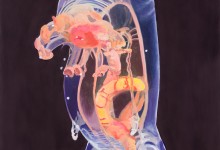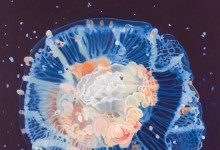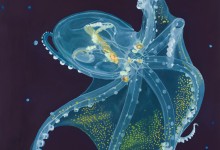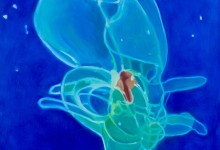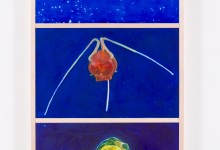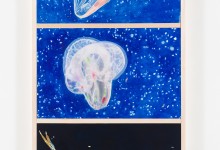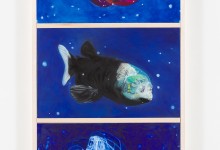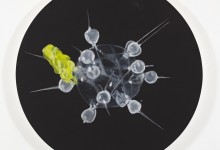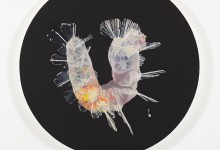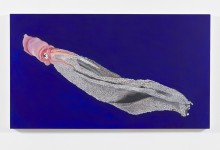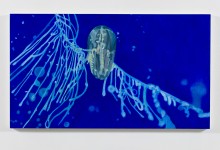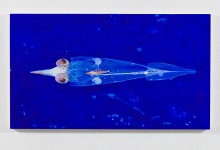Reception: Saturday, September 7, 2024, 3 p.m. to 5 p.m.
Colleen Wolstenholme: Into the Deep Blue Sea
Text by Kara Eckler
With Into the Deep Blue Sea, Nova Scotia-born, New Brunswick-based artist Colleen Wolstenholme presents a series of deep sea oil paintings and ink drawings, accompanied by a tent installation with projections, and wire sculptures reminiscent of sea kelp forests. In this exhibition we find many striking oceanic animals set against deep black and ultramarine backgrounds highlighted by hovering particles. These otherworldly creatures seem as if they could be science fiction aliens floating through space, they are so fantastical. The sculptures are tubes of knitted electroluminescent wire, and are shaped similarly to the tubes used to suck up manganese nodules from the deep sea floor. These nodules are used to make things such as the wire these sculptures are made from, adding a layer of socio-environmental nuance here. The five- sided tent is an immersive structure featuring projections that make it appear as if you are floating through starry space, when in fact, it is footage of marine snow in the deep sea.
This pensive exhibition was born of Wolstenholme’s experiences of confinement and caretaking during the pandemic. They speak to the human perception of the deep peace and silence at the bottom of the ocean, one of the last frontiers on the planet to be explored by mankind due to the difficulties presented in reaching it. During pandemic isolation, Wolstenholme sought solace in watching videos of deep sea creatures filmed by remotely-operated underwater vehicles. She found herself soothed by these floating images, impressed by the animals’ resilience in sustaining life in harsh conditions, and with the self-sufficiency of their bioluminescence—their ability to generate light in the darkness. Wolstenholme began to paint ctenophores and siphonophores, corals, anemones, and squid. She was fascinated by their transparency and their seeming fragility, which she depicts in appropriately fluid mediums of oil paint and ink. It is not new for Wolstenholme to combine art with her interests in science and technology; she is renowned for sculptures of oversized pharmaceutical drugs which affect the brain in different ways. Wolstenholme has also made a series about mapping the hippocampus which was the topic of her PhD thesis and created a body of work about hyperobjects and wind patterns. Through bringing what is unseen into the light to be witnessed through the eyes of an artist, she explores the poetry and idiosyncrasies of existence. Typically working in sculpture and jewelry, Wolstenholme nevertheless has maintained a painting practice as is evident from her skill in rendering the luminosity and diversity of these often newly-discovered beings. Although these works are portrayed with enough detail that they could serve as documentation of deep sea life, they have more of a sense of mystery and reverence, colour and mood, than what we would expect to see from the illustrations of a marine biologist. They are a meditation on life. There is something powerful about the ability of these animals to withstand the immense pressure in the depths that is evocative to us of reserves of immeasurable strength



